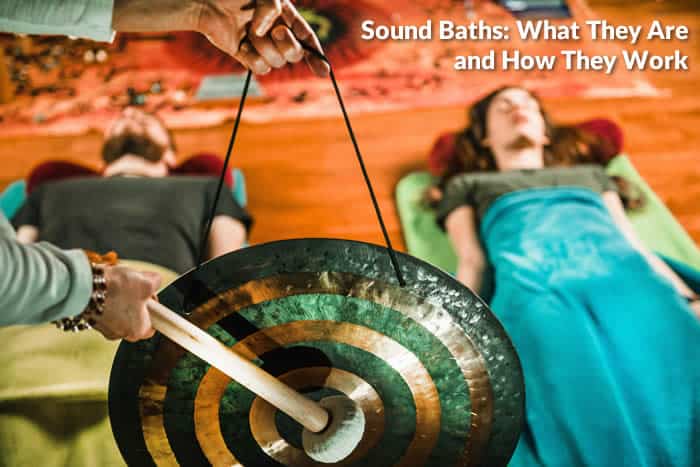

Roughly half of U.S. consumers say that wellness is a huge priority in their lives. (1) While some people take vitamins in an effort to feel better, others strive to develop healthier diet, exercise, and sleep habits. Another set of trending strategies involve the use of sound to promote wellness. (2) One such strategy is a sound bath.
What Is a Sound Bath?
The Cleveland Clinic explains that a sound bath consists of being “immersed in deep sound vibrations.” (3) These vibrations can be created by a variety of different objects or instruments, from a gong or tuning forks to metal, crystal, or Tibetan singing bowls.

The basis of a sound bath is similar to that of yoga. According to yoga philosophy, the body has several energy centers. If any of these energy centers is imbalanced, it can affect the body’s ability to be well. Thus, finding ways to open or even reset these centers promotes healing, and this can be accomplished through sound.
6 Sound Bath Benefits
The reasons behind sound baths’ growing popularity can vary from one person to another. For some, the sound bath may help them heal physically. Others use them to heal mentally, emotionally, or spiritually.
The Sound Healing Academy reports that the many benefits of sound baths include: (4)
- Less stress and anxiety
- Decreased feelings of fatigue
- Improved focus and clarity
- Better sleep
- Less muscle and joint pain
- Reduced heart rate
The Academy adds that people may also find that sound baths feel easier than meditation. This is because it requires less discipline since it only requires listening to the sounds.
But Do They Work? The Science Behind Sounds Baths
Research supports the use of sound healing for improved wellness. For instance, one study involved 62 participants who engaged in sound healing via singing bowls. What differences did they notice?
Subjects in their 30s had the greatest improvements in their spiritual well-being and feelings of depression. Those in their 50s also experienced improvements in spiritual well-being, along with strong improvements in feelings of tension. (5)
Another study involved 77 subjects who engaged in 40-minute, twice-monthly seated sound bath meditations. All had improvements in their positive affect (which includes positive emotions and expressions) and reductions in their negative affect (negative emotions and expressions). They also felt more relaxed, which was confirmed by measuring their heart rate variability during the sound bath sessions. (6)
Potential Disadvantages of Sound Baths
Although sound baths have been linked to several benefits, they’re not for everyone. Because the goal of these baths is to immerse you in sound, the sounds can be loud or intense. For some, this can feel overwhelming or overstimulate their auditory senses.
As a result, sound baths can make you feel worse instead of better. So, if you try them and notice that your wellness is trending the wrong way, this may not be the best or right approach for you.
What to Expect During a Sound Bath
During a sound bath, you may be asked to lie down or sit in a chair. Either way, the goal is to be in a comfortable position. Wearing comfortable clothes helps as well. Close your eyes and the sounds begin.
Sound baths take you on a journey. This journey can make you feel emotional, with responses ranging from feeling uncomfortable to experiencing a feeling of euphoria. The deeper you go into your meditation, the more you will likely relax. Some people even fall asleep during sound bath sessions. That’s okay. This is a common response.
Afterward, you may notice that you feel less intense, but it’s also possible to experience increases in energy. Everyone is impacted in different ways.
Aim to do one to two sound bath sessions a month. You may even time them based on how you respond. If they help you reduce stress, for instance, plan to do a sound bath when you know your stress levels will be high. If they give you more energy, a sound bath may be more helpful when you’re super busy, giving you the “oomph” you need to tend to all your obligations.
Sound Bath Etiquette
Like with other wellness activities, adhering to certain etiquette can improve your and others’ sound bath experience. The Soundbath Center shares that this etiquette includes: (7)
• Not touching the sound instruments.
• Refrain from wearing perfume or another strong scent so it doesn’t bother other practitioners.
• Do not use alcohol or other substances before a sound session.
• Arriving 15 minutes early so you’re ready when the sound bath starts and turning off your cell phone.
• No talking during the session and lying on your side if you tend to fall asleep and snore.
• Breathing naturally during non-breathwork portions of the sound bath session.
Have you ever tried a sound bath? If so, we’d love to hear about it! Comment below and tell us (and our readers) what you thought and how it made you feel.




